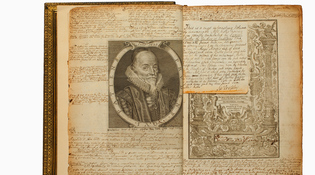 loading
loading
Arts & CultureObject lessonMarginalia  Lillian Goldman Law LibraryThis edition of Sir Edward Coke's First Part of the Institutes of the Lawes of England (1633) is decorated by marginal comments in several hands and languages. View full image
Written in English, Latin, and ancient Greek, handwritten notes creep up and across the page, nearly overwhelming the margins of this seventeenth-century treatise on English law. Cicero’s claim that ancient Rome’s “house of lawyers was surely an oracle for all citizens” appears near thoughts on the use of “arithmetical figures” across the centuries, while across the page a careful pen recounts Aristotle’s views on justice. While the printed text of this edition of Sir Edward Coke’s 1633 volume, The First Part of the Institutes of the Lawes of England, found in the rare-book collection of the Yale Law School library, conveys early modern English law as understood by one of the period’s most famous lawyers, the marginalia of this volume teaches just as much about how that law was studied and practiced, and how words on the margins helped shape the common law. A leading historian once wrote that what Sir Francis Bacon and William Shakespeare were to philosophy and literature, Sir Edward Coke was to the common law—the legal tradition drawn from judicial decisions. Coke, who served as solicitor general and attorney general to Queen Elizabeth I, was also chief justice during the reign of James I. During his conflicts with the king, Coke helped establish the concept of judicial review; after being driven from his judgeship by the monarch, he became an active member of parliament and a harsh critic of Stuart rule. Coke assured his legacy among lawyers through his published law reports, which described arguments made by lawyers and judges in court, and the Institutes, which helped disseminate knowledge of the common law. Although formally a commentary on a historic legal treatise, the volume also served as an up-to-date legal reference for practicing lawyers, containing summaries of contemporary property law and Coke’s views on jurisprudence. This particular volume was owned by satirist Samuel Butler, who shared the book with his friend, the lawyer William Longueville. The handwriting of both men appears throughout the margins, and their different interests are revealed by their respective marginalia: Longueville’s notes focus largely on legal topics, while Butler’s cite vast numbers of literary sources. (Many other authors, most unknown, also added comments.) Since the medieval period in Europe, law students had used marginal notations in their own manuscripts to clarify the law. English law students would copy each other’s manuscripts, rejecting some text and adopting some marginalia. This process of copying and amending manuscripts cultivated a tradition of legal commentary that began during a lawyer’s training and continued throughout one’s career. The fifteenth century brought the advent of printed law books, but the practice of adding marginalia did not decline. Marginalia allowed lawyers to update their printed books with references to recent cases, statutes, and treatises. Indeed, printers sometimes provided law books with generous margins specifically for handwritten notes. The marginalia would remind a lawyer of useful precedents or insights to use in court—insights which, over time, were adopted by judges in their opinions or by lawyers in treatises. Ultimately, what began as florid scrawl in the corner of a page could dramatically affect the evolving law.
The comment period has expired.
|
|